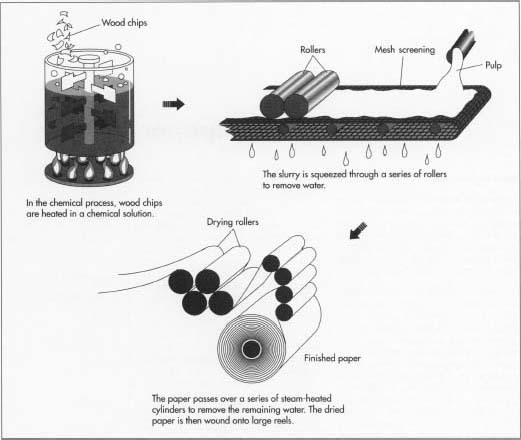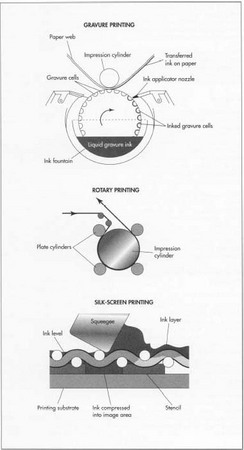Wallpaper
Background
Wallpaper is a nonwoven (paper) or woven (fabric) backing, decoratively printed for application to walls of a residence or business. Wallpaper is not considered essential to the decoration of a structure; however, it has become a primary method by which to impart style, atmosphere, or color into a room.
The wallpaper industry divides the manufacture of wallpaper into those used in residences and those hung in businesses or other public buildings. The two categories of paper differ in weight, serviceability, and quality standards. Residential-use wallpapers are made from various materials and can be purchased prepasted or unpasted. There are no mandated serviceability tests for residential papers. The commercial-grade wallpapers are divided into categories based on weight, backing composition, and laminate/coating thickness. All commercial-use wallpapers must have a vinyl surface and pass rigorous physical and visual tests as mandated by the Chemical Fabrics and Film Association.
There are four popular methods used to print wallpapers, and designers choose the printing technique based on cost as well as aesthetics.
History
The earliest wallpapers used in Europe as early as the thirteenth century were painted with images of popular religious icons. These "domino papers" were pasted within homes of the devout; however, they also enlivened the bleak homes of the poor. Within the next few centuries, papers were hand block-printed, but only remained popular with the poor.
By the sixteenth century, however, more expensive wallcovering, depicting tapestries hung in homes of nobility, became popular with the middle class. Small sheets either carried a repeating image, or several blocks produced a pattern spread across many sheets. Fashionable eighteenth century Americans puchased wallpapers from France and England; "paper stainers" were producing wallpapers in this country by the early nineteenth century if not before.
Two problems plagued wallpaper stainers until the mid-nineteenth century. One was the problem of producing long sheets of paper for printing, the other was printing attractive wallpaper inexpensively. Until the mid-1700s, rag-based paper was individually printed in sheets, then applied to walls. Then, wallpaper manufacturers were pasting the pieces together, ground coating them, then printing. In the late nineteenth century, the paper industry developed "endless" paper, or paper made in very long strips. By 1870, wood pulp had supplanted rag stock, resulting in a very cheap backing for wallcovering.
In the nineteenth century, printing costs were greatly reduced by abandoning labor-intensive block printing in favor of cylinder printing. Wood-block printers applied each color by hand using a separate block for each color in the pattern. Thus, each block had to be inked with the right color, pressed down on the paper, tapped to ensure a quality imprint, lifted up, and reinked as the printer moved down the paper roll—an expensive process. Wood blocks were supplanted by copper cylinders, which carried the design below the surface of the roll, each roll printing a single color. The cylinders were mounted within one machine and

More recent advances include development of additional printing methods, new inks and solvents, and use of latex and vinyl as coatings or laminates.
Raw Materials
Wallpaper consists of a backing, ground coat, applied ink, and sometimes paste on the backing used to adhere the paper to the wall. Non-woven backings can be of ground wood, wood pulp, or wood pulp with synthetic material. Woven backings are those made of sturdy woven textiles such as drill (heavy woven cotton much like jean material). The woven backing is then coated and printed.
The ground coat is the background color laid on the surface, which receives the printed pattern. Coatings or laminates are made of latex or vinyl (polyvinyl chloride) and render the paper durable and strippable. Ground coats also include additives that enhance the ease of handling, opacity, and drapability of the paper.
The paper is printed with inks composed of pigment and a vehicle which ties the ink to the backing. Solvents can be acetone or water, for example. Printers choose inks carefully as the solvents they include affect the drying time and production time between color applications of the paper.
Pastes may or may not be applied to wallpapers. If they are, they are usually made up of cornstarch or wheat starch and are applied wet to the backing. Prepasted wallpapers must be rewetted for adhesion to the wall.
Design
New wallpaper designs are generally derived from sketches purchased from a staff designer or freelance wallpaper designer. The artist lays out the design on tracing paper and completes at least a partial pencil sketch. The marketing and design staff will then decide if the paper is the right "fit" for a specific look or line. If the design is accepted, the artist produces a full-scale color sketch in various colors and palettes.
After the printing process is chosen, the sketch is fine tuned to fit the requirements of the printing process and the pattern is sent to the engraver or screen-maker. Once the cylinder or screens are in place and a few pattern repeats are printed, a "strike off' (sample wallpaper) is printed to test the color and pattern. When okayed, the paper is commercially printed in large runs.
The Manufacturing
Process
Making the paper
-
1 Ground wood sheets of paper are produced by using an entire tree, removing the bark, and pressing the tree against a revolving tread, which grinds the wood into slurry. The slurry is used to make a ground wood sheet—a relatively inexpensive wall-paper backing.
Wood pulp sheets are made by debarking a tree and chipping the tree into a slurry. The mixture is run through a pulp mill where chlorine dioxide and oxygen are added to separate the lignin (which cements the woody cell walls together) from the rest of the wood pulp and bleaches the pulp. Wood pulp sheets with fibers can have synthetic fibers added to give the paper additional texture.
A roll of paper from the paper mill is 65 in (1.65 m) wide, possibly as long as 22,000 ft (6,706 m), and weighs approximately one ton. Once sold to a printer, each paper roll is cut into six sub-rolls which are 21 in (53 cm) wide by 10,000 ft (3,048 m) long.
Coating
-
2 Before the pattern is printed, the backing must be coated with a ground color. Ground wood sheets are coated with colored vinyl (PVC), which varies in thickness depending on the durability and strippability of paper under production. Vinyl may also be laminated to backings for exceptional serviceability.
Wood pulp sheets are coated with one or all of the following: kaolin clay for drapability, titanium dioxide for opacity, and latex for ease in handling and color.
Printing
There are four possible types of printing techniques.
- 3 Surface printing. Metal rollers impregnated with a raised rubber pattern are mounted on a single machine. Ink is applied to the surface roller, and the ink lays in the hills or rubber pattern sitting above the surface of the roller. The ink is then pressed onto the paper.
- 4 Gravure printing. Each color of the pattern is printed with a single roller. Copper cylinders are laser-etched then chrome-plated for durability. Large gravure-printing machines hold a maximum of 12 cylinders that together create the whole pattern. The paper roll moves to one cylinder, a back roller picks up color and pushes it against an engraved roller. A steel doctor blade pushes against the engraved cylinder, forcing ink into the etched detail. A rubber roller then presses paper against the cylinder, enabling it to pick up the ink in the valleys of the engraving. Finally, rollers carry the paper away from the cylinder into a dryer, where the ink is set. Once the ink is dry, the process begins again with the next cylinder.
-
5 Silk screen printing. Stencils for each color present in the pattern are created from silk mesh screen, using a photographic
process. First, a photographic negative is made of the pattern. Then, a silk screen approximately 36 in (91 cm) long is stretched taut over a magnesium or wood frame. The screen is coated with a light sensitive emulsion, and the negative is placed on top of the screen. Once hit with bright light, the emulsion hardens in the areas not covered by the negative, forming a stencil. Patterns can be printed onto wall-paper by one of several printing methods, including gravure printing, rotary printing, and silk-screen printing.
Patterns can be printed onto wall-paper by one of several printing methods, including gravure printing, rotary printing, and silk-screen printing.Paper is set upon a long table, a screen stencil is placed on top, and ink is applied by a scraper or squeegee. Color is deposited on the paper where the screen permits the ink to pass through to the paper. The stencil is picked up, moved down the paper, and inked again along the entire length of the paper roll.
Before the next color is applied, the ink is thoroughly dried. Each screen is carefully put down with blocks, guides, etc. so that the pattern is aligned and repeats without breaks. Hand printing produces patterns with thick, evenly applied color. Theoretically, the number of colors used in the screening process is limitless; however, the high cost of hand printing necessarily limits the number of colors companies can include in the pattern.
- 6 Rotary printing. This type of printing process combines the mechanics of gravure printing with the precision of photographically produced stencils. Mesh stencils are wrapped around hollow tubes mounted within a machine. Ink continuously flows through the film-wrapped tubes and onto paper, imparting a tremendous amount of color (a maximum of 12 colors). This technique resembles the more expensive silk-screening, but it can print much more quickly—approximately 80 yd (73.12 m) of wallpaper per minute.
Prepasting
- 7 Printed wallpaper is rolled with a wet cornstarch or wheat starch-based coating and then dried.
Packaging
- 8 Residential-use wallpapers are cut down from 3,000 yd (2,742 m) rolls to 15 yd (13.71 m) rolls. Commercial-use rolls are generally packaged in 30, 45, and 60 yd (27, 41, and 55 m) rolls. A printed label, run number, and hanging instructions are placed against each roll and shrink wrapped together. Rolls are stored in a warehouse until final shipment.
Quality Control
The Chemical Fabric and Film Association (CFFA) has devised quality standards for commercial-use vinyl coated wallcoverings. The various categories of commercial-use papers have different physical test requirements specified in CFFA Quality Standard documents. All papers must undergo testing on such attributes as minimum coating weight, tensile strength, tear strength, coating adhesion, abrasion resistance, flame spread, smoke development, shrinkage, heat aging, stain resistance, etc.
Each wallpaper printing company conducts visual inspections in the form of spot checks or representative product samplings to ensure their product conforms to certain values established by the manufacturer. Generally, wood pulp and ground wood paper backings are given visual checks to see if there is foreign matter imbedded in the backing. When woven backings are received by printers, the printer checks thread count and physically tests the fabric for minimum requirements.
As the backing is printed, constant visual checks ensure proper adhesion of vinyl to backing, correct color, no streaking or unwanted shading, trimmed edges, etc. Representative samples are physically and visually examined before being cut into smaller rolls.
Where to Learn More
Books
Chemical Fabrics and Film Association, Inc. CFFA Quality Standard for Vinyl Coated Wallcovering. Cleveland, OH: CFFA, 1995.
Lynn, Catherine. Wallpaper in America. New York: W. W. Norton, 1980.
Swedlow, Robert M. Step by Step Guide to Screen-Process Printing. Englewood Cliffs, NJ: Prentice Hall, 1985.
Teynac, Francoise, et al. Wallpaper: A History. New York: Rizzoli, 1982.
— Nancy EV Bryk
Thanks,
Tressa